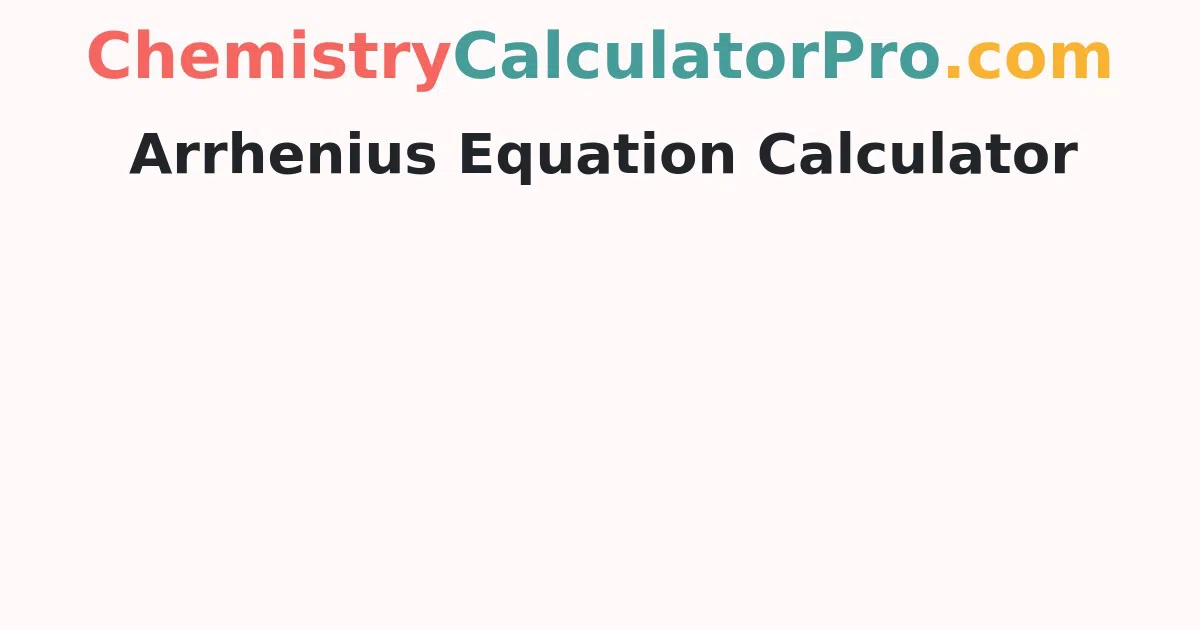Arrhenius Equation Calculator
Take the help of Arrhenius Equation calculator tool to know the rate constant in a fraction of seconds easily. Just you have to give inputs ie.arrhenius constant, activation energy, temperature and tap on the calculate button to get the result of rate constant quickly.
What is the Arrhenius Equation?
The Arrhenius equation is an expression that provides a relationship between the rate constant (of a chemical reaction), the absolute temperature, and the A factor (also known as the pre-exponential factor; can be visualised as the frequency of correctly oriented collisions between reactant particles). It provides insight into the dependence of reaction rates on the absolute temperature
If the activation energy is expressed in terms of energy per reactant molecule, the universal gas constant must be replaced with the Boltzmann constant (kB) in the Arrhenius equation.
Arrhenius Equation Formula
The Arrhenius equation explains how the rate of a reaction varies based on the temperature or rate constant. The general formula of the Arrhenius equation is K = Ae( - E a / R * T )
- Where, k is the rate constant
- A is the pre-exponential factor of Arrhenius constant
- Ea is the activation energy
- R is the universal gas constant i.e 8.314 J/K mol
- T is the temperature
When the reaction temperature increases, the number of successful collisions also increases exponentially. The Arrhenius equation in logarithmic form is ln(k) = (-E/R)*(1/T) + ln(A)
How to find the Rate of Reaction?
Go through the simple steps to find the rate of reaction with the help of Arrhenius Equation
- Step 1: To know the values of arrhenius constant, temperature and activation energy.
- Step 2: Find the value of temperature and rate constant then divided by activation energy to get the product
- Step 3: Find the exponential of the product to know the result.
- Step 4: Multiply the result with arrhenius constant to find the rate of reaction.
- Step 5: Enter the values , click the calculate button to avail the rate of reaction
Arrhenius Equation Examples
Question 1: The activation energy of a chemical reaction is 100 kJ/mol and it’s A factor is 10 M-1s-1. Find the rate constant of this equation at a temperature of 300 K.
Solution:
Given,
Ea = 100 kJ.mol-1 = 100000 J.mol-1
A = 10 M-1s-1, ln(A) = 2.3 (approx.)
T = 300 K , R = 8.314 J.mol-1.K-1
The value of the rate constant can be obtained from the logarithmic form of the Arrhenius equation, is
ln k = ln(A) – (Ea/RT)
ln k = 2.3 – (100000 J.mol-1)/(8.314 J.mol-1.K-1)*(300K)
ln k = 2.3 – 40.1
ln k = -37.8
k = 3.8341*10-17 M-1s-1 (from the units of the A factor)
Question 2: The activation energy of a chemical reaction is 200 J/mol and it’s A factor is 10 M-1s-1. Find the rate constant of this equation at a temperature of 400 K.
Solution:
Given that,
Ea = 200 kJ.mol-1 = 200000 J.mol-
A = 10 M-1s-1, ln(A) = 2.3 (approx.)
T = 400 K
R = 8.314 J.mol-1.K-1
The logarithmic form of the Arrhenius equation, is
ln k = ln(A) – (Ea/RT)
lnk = 2.3 - ( 200000 / 8.314 * 400)
= 2.3 - ( 200000/3325.6)
= 2.3 - 60.1 = -57.8
k = 5.841*10-17 M-1s-1 (from the units of the A factor)
FAQ’s on Arrhenius Equation Calculator
1. What is activation energy?
It is the minimum energy required for reactants to transform into products. It is denoted by Ea. The SI units for activation energy are joules (J) and or kilo-joules per mole (kJ/mol) or kilo-calories per mole (kcal/mol).
2. What is the importance of the Arrhenius Equation?
The Arrhenius Equation importance is provided here
- 1.The equation allows to account for the factors which have an impact on the rate of the reaction that can't be calculated using the rate law.
- 2.One can determine the effect of the energy barrier, temperature, frequency, catalyst pressure, the orientation of collisions using this equation.
3. What is kB is Arrhenius Equation?
Arrhenius Equation is k = A x e(-Ea/(kB x T)). Here, kB is the Boltzmann constant and its value is 1.380649 x 10-23 J/K.
4. What is ‘A’ in the Arrhenius Equation?
The symbol ‘A’ is the frequency factor or the Arrhenius factor. It deals with the collisions between molecules and can be thought of as the frequency of correctly oriented collisions between molecules that have sufficient energy to spark a chemical reaction.
